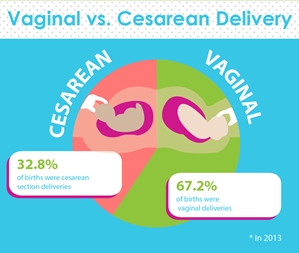Wondering how likely a cesarean is for your delivery? The Centers for Disease Control and Prevention have the numbers for you. Looking back to 2013 and the 3,927,231 babies born that year, the CDC reports that 67.3 percent were born by vaginal delivery. That means 32.7 percent came into the world by C-section. That's nearly double what it was during the previous decade. Some health care professionals are shaking their heads at the increase in C-sections. Here's why:
Major surgery
We don't often hear it described in so many words, but a C-section is major abdominal surgery. Submitting to the operating table means going under the knife, obviously, and cutting through skin, tissue and uterine wall to retrieve baby and the placenta. Recovery spans six weeks and C-sections come with an increased risk of infections, blood loss and potentially serious complications.
The risk factors
Of all the C-sections to take place each year, 5 percent are deemed medical emergencies and are lifesaving procedures for both mom and child. Three percent of each year's C-sections are completely elective, meaning there's no medical reason for a mom-to-be to go under the knife. The remaining group – the vast majority – has a risk factor that makes doctors too nervous to proceed with a vaginal delivery. These factors may include an older maternal age, a larger baby, an overdue baby or a slow progression of labor. These days, with superior ultrasound technology picking up even the slightest problem, doctors are quicker than ever to send an expectant mom for a C-section.
What the experts say
"There's no question that there's a basic, irreducible number of C-sections we need to do for women's health. But there's also no question that we're doing too many in the United States," Dr. Hope Ricciotti, associate professor of obstetrics, gynecology and reproductive biology at Harvard Medical School, told CNN. And she isn't alone. A growing number of medical professionals are raising their voices against routine C-sections, citing uncomplicated vaginal deliveries as the safest route for new moms.
Your takeaways
When the situation demands it, a C-section can be a truly lifesaving procedure, safeguarding the health of both baby and mom. Talk to your doctor about his or her thoughts on this surgery – and be sure to outline your own in your birth plan. The better prepared for birth you are, the smoother it will go, whether it's in the operating room or not.
